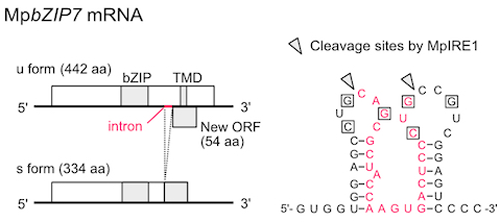- 著者
- Masato Nakamura Mamoru Nozaki Yuji Iwata Nozomu Koizumi Yasushi Sato
- 出版者
- Japanese Society for Plant Biotechnology
- 雑誌
- Plant Biotechnology (ISSN:13424580)
- 巻号頁・発行日
- vol.39, no.2, pp.129-138, 2022-06-25 (Released:2022-06-25)
- 参考文献数
- 48
- 被引用文献数
- 2
Endoplasmic reticulum (ER) stress activates unfolded protein responses (UPRs), such as promoting protein folding under the control of specific gene expression. Our previous study showed that ER stress induced by ER stress inducers such as tunicamycin (Tm), an inhibitor of N-linked glycan synthesis, causes ectopic lignin deposition in Arabidopsis roots, but the relationship between UPR and ectopic lignin deposition remains unclear. The receptor-like kinase THESEUS1 (THE1) has been shown to sense cell wall damage (CWD) induced in Arabidopsis by cellulose synthase inhibitors such as isoxaben (ISO) and to activate ectopic lignin deposition. In this study, we assessed the involvement of THE1 in ectopic lignin deposition caused by the ER stress inducer Tm. The loss-of-function mutation of THE1, the1-3, suppressed Tm-induced root growth inhibition and ectopic lignin deposition, revealing that THE1 is involved in root growth defects and ectopic lignin deposition caused by ER stress. Similarly, ISO treatment induced ectopic lignin deposition as well as the expression of the UPR marker genes binding protein 3 (BiP3) and ER-localized DnaJ 3b (ERdj3b). Conversely, in the the1-3 mutant, ISO-induced ectopic lignin deposition and the expression of BiP3 and ERdj3b were suppressed. These results showed that THE1 is involved in not only root growth inhibition and ectopic lignin deposition caused by ER stress but also CWD-induced UPR.
- 著者
- Sho Takeda Taisuke Togawa Kei-ichiro Mishiba Katsuyuki T. Yamato Yuji Iwata Nozomu Koizumi
- 出版者
- Japanese Society for Plant Biotechnology
- 雑誌
- Plant Biotechnology (ISSN:13424580)
- 巻号頁・発行日
- vol.39, no.3, pp.303-310, 2022-09-25 (Released:2022-09-25)
- 参考文献数
- 37
- 被引用文献数
- 2
The unfolded protein response (UPR) or the endoplasmic reticulum (ER) stress response is a homeostatic cellular response conserved in eukaryotes to alleviate the accumulation of unfolded proteins in the ER. In the present study, we characterized the UPR in the liverwort Marchantia polymorpha to obtain insights into the conservation and divergence of the UPR in the land plants. We demonstrate that the most conserved UPR transducer in eukaryotes, IRE1, is conserved in M. polymorpha, which harbors a single gene encoding IRE1. We showed that MpIRE1 mediates cytoplasmic splicing of mRNA encoding MpbZIP7, a M. polymorpha homolog of bZIP60 in flowering plants, and upregulation of ER chaperone genes in response to the ER stress inducer tunicamycin. We further showed that MpIRE1 also mediates downregulation of genes encoding secretory and membrane proteins in response to ER stress, indicating the conservation of regulated IRE1-dependent decay of mRNA. Consistent with their roles in the UPR, Mpire1ge and Mpbzip7ge mutants exhibited higher sensitivity to ER stress. Furthermore, an Mpire1ge mutant also exhibited retarded growth even without ER stress inducers, indicating the importance of MpIRE1 for vegetative growth in addition to alleviation of ER stress. The present study provides insights into the evolution of the UPR in land plants.
